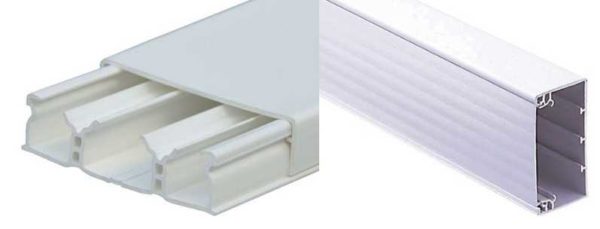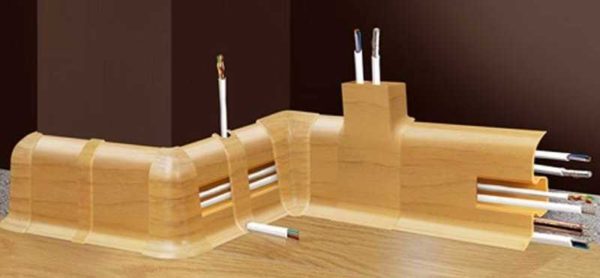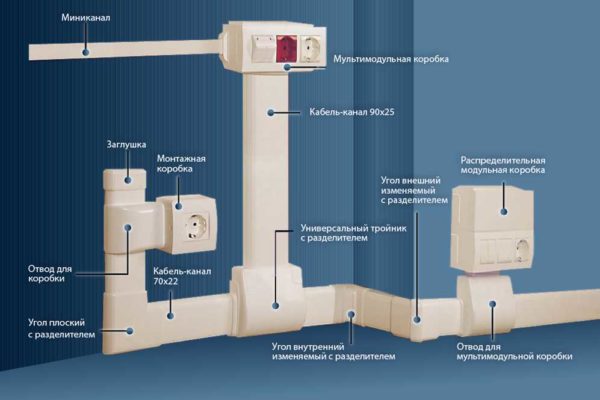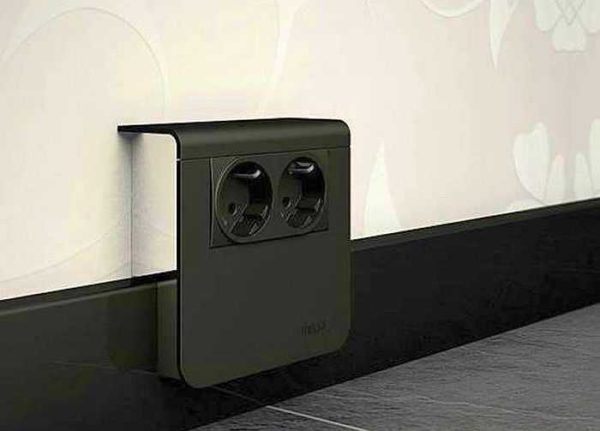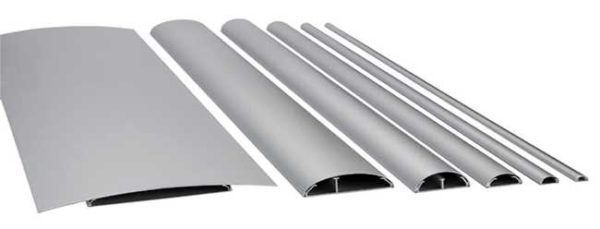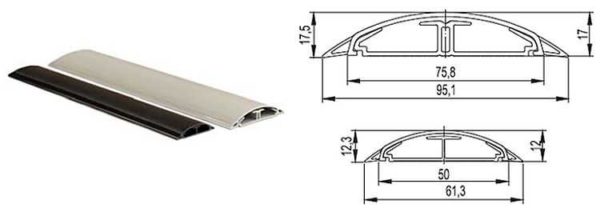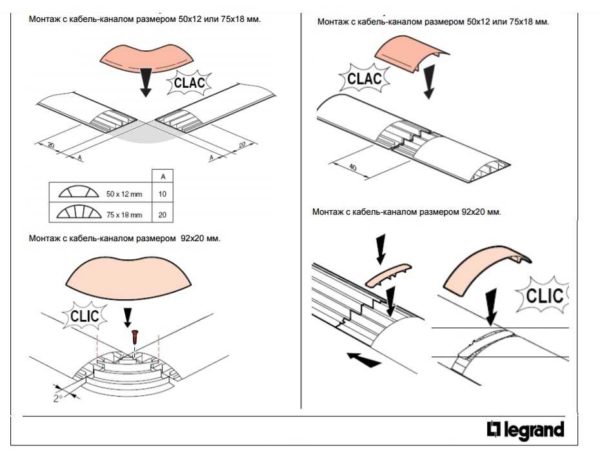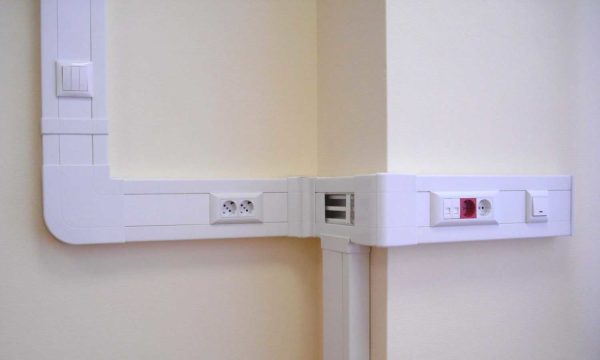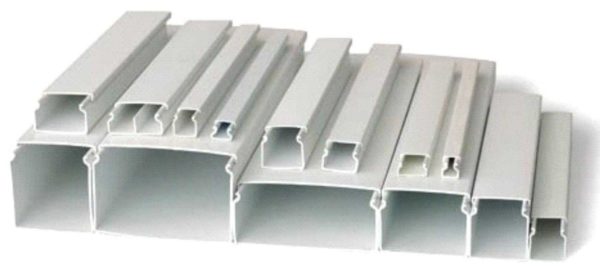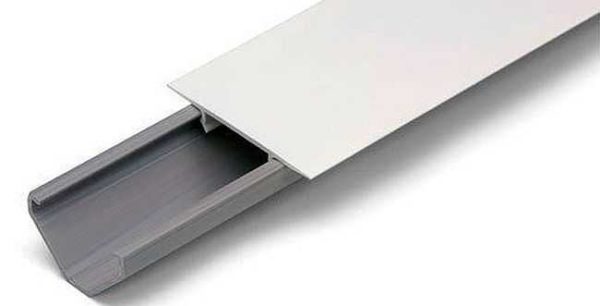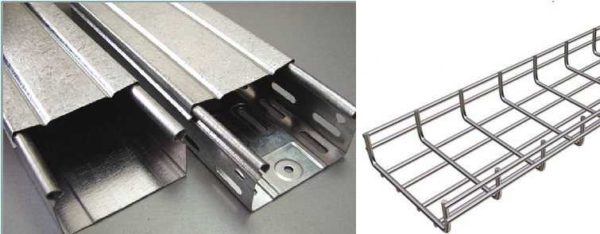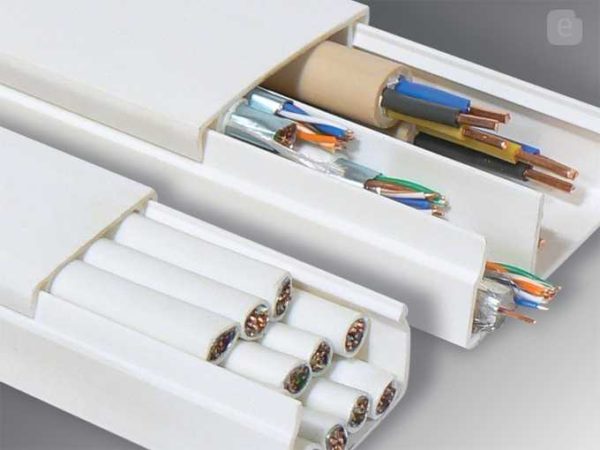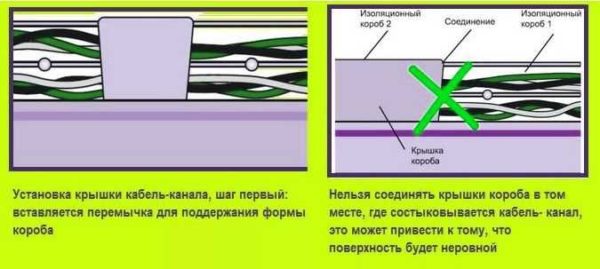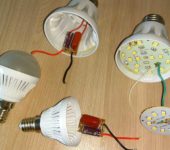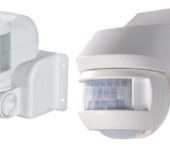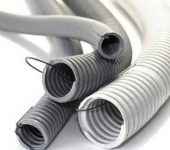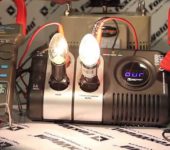What are the cable channels (boxes, trays)
One of the ways of open laying of wires in apartments and houses is cable channels. They are used in cases where a hidden gasket is for some reason impossible or undesirable.
The content of the article
Definition, structure, purpose
Cable ducts are plastic or metal boxes for hidden or open laying of wires and cables. They can be used both outdoors and indoors. They are also called cable trays and boxes, sometimes they add the word "electrical"
They consist of a body and a cover. The sections are mostly rectangular and square, but there are others, more specific (they will also be discussed later). The body can be solid or perforated. Perforated enclosures are rarely needed for better ventilation and faster cooling.
The cover and the housing of the cable channel are connected with a lock - they snap into place. This is why cable trays are convenient - you can open, check, lay a new one or remove unnecessary wire at any time. When buying, pay attention to the structure and quality of the locks - ease of use depends on them. The best, at this stage, is a double lock. It provides sufficient hold and allows the lid to be opened / closed repeatedly.
The inner space of the cable duct can be divided by partitions. This is done in order to be able to separate power (wiring) and low-current (TV, Internet, telephone, etc.) cables. It is advisable to lay them separately so that they do not interfere with each other. Some firms have developed a design so that the partitions can be installed independently. They are sold separately and fit over the tabs on the inner wall of the case (example of such tabs in the photo on the right).
Material - metal or plastic. If you choose plastic cable channels, please note that it must be non-flammable or non-flammable (read in the description). Ideally, if it still produces little smoke - just in case.
Types and sizes
The types of cable channels differ from each other mainly in shape, only some of them use special materials - for example, transparent plastic or aluminum and its alloys.
Skirting cable ducts
If you want to secretly lay cables and not hammer the walls at the same time, take a closer look at the skirting cable channels. These are a kind of plastic skirting boards, in the inner cavities of which the wires are laid. They are available in different colors, suitable for design in different styles.
Manufacturers of whole systems of skirting cable ducts, in addition to long trays, produce a number of additional devices that allow a colleague of any shape. These are external and internal corners, differently shaped taps, plugs, mounting and multi-module boxes, on which switches and sockets can be installed.
There is also an option with the installation of sockets directly at the level of the baseboard. For older people, this is not the best option, and for young people, low inclines are not a problem. But not so attention-getting.
This type of cable channels is available in different colors - from white, gray and black to colors that imitate wood and metal surfaces. The disadvantage is the rather high price, although it cannot be compared with the payment for wall chasing.
Available sizes of SL Hager products - 20 * 50 mm, 20 * 70 mm, 15 * 100 mm, 25 * 100 mm. The Legrand firm has two series: mini with sizes - 20 * 12.5 mm, 32 * 12.5 mm, 40 * 12.5 mm, 32 * 16 mm, 40 * 16 mm, 60 * 60 mm, 60 * 20 mm, 75 * 20 mm. The second series - DPL has the following dimensions: 35 * 80 mm, 35 * 105 mm, 50 * 80 mm, 50 * 105 mm, 50 * 150 mm, 65 * 150 mm.
Another video about another system of skirting cable channels.
p;
Floor
This type of cable trunking also differs in shape and installation method. It is installed on the floor, because on one side it has a rounded shape, so it does not interfere with movement. Available in impact-resistant plastic or aluminum. The form is the same.
Floor trays for cables are used as part of the system - when you need to bring wiring to a table or lighting fixture that is far from the walls. It successfully replaces carriers and extension cords.
The following sizes are available for sale:
- 50 * 12 mm;
- 75 * 17 mm;
- 92 * 20mm;
- 160 * 65 mm;
The color scheme does not differ in variety: usually there are gray, white and black. Joints of two strips, corners and turns can be made using fittings of suitable size. First, the lower part is mounted, the conductors are laid, after which the cover is snapped on.
Then accessories are installed in the right places - corners, joints. They are made in such a way that they simply snap into place, providing a secure fit. In this case, the degree of protection is even maintained (usually IP40).
Parapet
Parapet cable channels (they are also called trunk channels) are similar in structure to baseboards. They differ slightly in shape, but mainly in that they are mounted above the floor level. They also consist of various elements that allow you to assemble any configuration.
They are mainly used in offices or businesses. If such structures are mounted in private houses or apartments, then they try to match the color of the wall decoration. Usually they close the routes connecting the outdoor and indoor units air conditioners.
Dimensions can be as follows:
- width 80 mm, 100 mm, 120 mm, 150 mm;
- height 40 mm, 55 mm, 60 mm.
For each type of section there is a set of shaped elements - external and internal corners, plugs, splitters, etc. There may be several colors, but the main ones are white and milky. The rest are hard to find.
Mini
Reduced version of parapet cable channels, in which you can lay a number of conductors - television, telephone, for the Internet.
When using this product, the corners are not made out with special shaped parts, but by sawing the box at the desired angle (usually 45 ° only taking into account whether it is internal or external).
Dimensions can be as follows:
- width 10 mm, 12 mm, 16 mm, 20 mm, 25 mm, 40 mm, 60 mm, 80 mm, 100 mm.
- height - 10 mm, 12 mm, 16 mm, 20 mm, 25 mm, 40 mm, 60 mm.
Combinations of these sizes provide a wide variety of options. There are wide and low, there are narrow and high, so there is a choice and you can pick up.
Corner
Due to their design, angled cable ducts can be installed at the junction of the wall and ceiling or instead of a plinth. With careful execution of the corners (they must also be cut off with a hacksaw at the desired angle), they look like a decorative element.
The disadvantage is that there is not as much space in them as in baseboards, and the walls are thinner, so there is a high probability of damage when laying below. The most common sizes are 40 * 40 mm, so you can't put a lot of cables in them.
For LED strips
This is a kind of corner cable tray option. They differ in that the cover is made of transparent or translucent plastic.
They are mounted under the ceiling in the corners, on the bottom panel of kitchen cabinets or in the cabinets and cupboards themselves. Wiring is not laid in them, because the organization of the internal space is completely different - they make a platform on which it is convenient to attach a tape of LEDs. Its position is chosen based on the required direction of the light flux.
Metal cable trays
This type of product in private homes is mainly used for wiring in combustible walls - in construction frame houses or panel. Inside the wall and ceiling, trays are placed, cables are pulled through them, and in the right places they are led out through the cladding of the walls or ceiling.
Also, some types (wire cable channels) are used when lighting a tension or false ceiling... With their use, the installation time is drastically reduced, because instead of installing a large number of small fasteners, you need to attach several hangers for trays, and then lay all the cables in them.
Dimensions of metal cable trays:
- width from 50 mm, 80 mm, 100 mm, 150 mm, 200 mm and further up to 600 mm with a step of 100 mm;
- height - 50 mm, 80 mm, 100 mm;
- the length of one piece is 3m.
So it will be possible to choose for any number of conductors.
Installation rules
The installation procedure depends on whether fittings will be used - corners, branches and plugs or not. If there are any, the manufacturer gives clear recommendations on how much distance should be left for correct installation. They should be adhered to with millimeter precision. Then everything looks neat. We will talk in more detail below about the basic rules for installing cable channels of the usual type.
How to choose size
If you decide to lay wires in cable channels, first you need to decide what size they are needed. The dimensions are selected based on the number and size of the conductors that will need to be laid and add some margin for the future - so that, if necessary, one or two more wires can be laid.
The number of conductors in the cable channel is not standardized. The main thing is to be able to close the lid without any problems. A limitation may be the need for separate placement of power and low-current cables. In this case, the cross-section is selected so that there is at least a small distance between the groups of cables.
Installation procedure and features
According to the rules, the wiring is laid horizontally and vertically, inclined installation is allowed only on stairs. In other cases, the rules do not deviate even with open wiring. To obtain an even cut when installing plastic cable channels with thin stacks, use scissors for metal or others, but the cutting edge must be sharp. Aluminum and metal trays are cut with a hacksaw for metal. Thick plastic can also be cut with the same tool - there will be an even edge and the profile will not wrinkle.
If you need a piece of a certain length, for example, you need to cut it off in this order: snap the lid, align the edge, mark the lid and the body at the same time. Then you can cut it separately. In this order, the length of both products will be the same.
Please note that when passing the corner, the cover is not cut into two parts, but only the side walls are trimmed so that it can be bent. Do not forget that when bypassing the outer corner, the cover should be longer than the tray; in this case, it is better to mark the cuts on it after the channel cable body is fixed.
A non-wooden surface, the cable channel is attached to nails with a wide head (self-tapping screws can be used), to plaster or plasterboard walls - to self-tapping screws.For installation on brick or concrete walls, anchoring is required. The step of fastening the fasteners is about 60-70 cm, in the places where the profile ends and at the joints, the fasteners are installed at a distance of 3-5 cm from the edge.
If two pieces of cable channels fit together, the cover must be positioned so that the joints of the body and cover do not match. Otherwise, the joint will be too noticeable and unevenness may form, which will further emphasize the joint.
We put the conductors in the mounted cases. To prevent the walls of the cable channels from sagging, we install supporting jumpers with some step, and then snap the covers. At this, the wiring in the cable channels can be considered complete.

